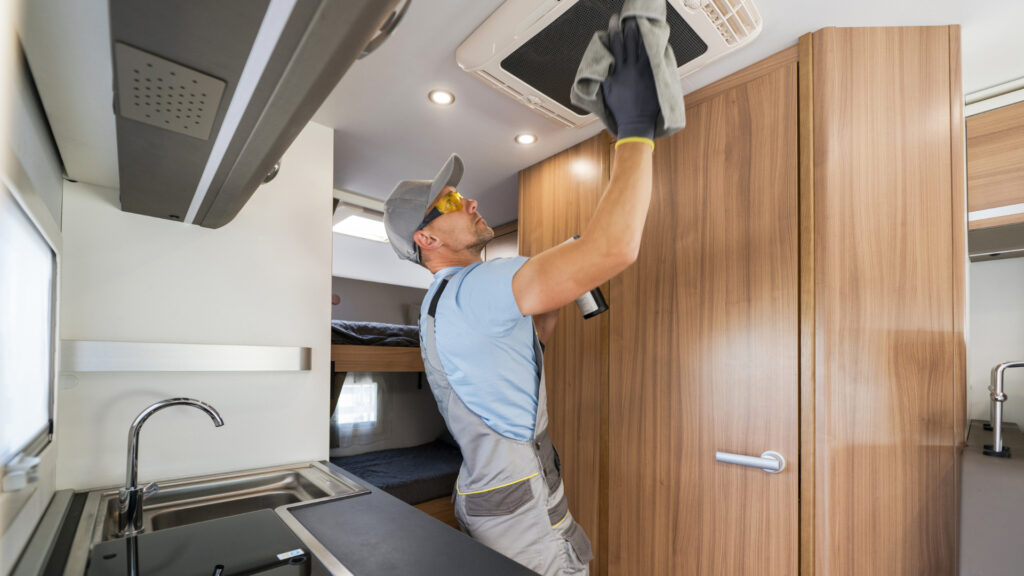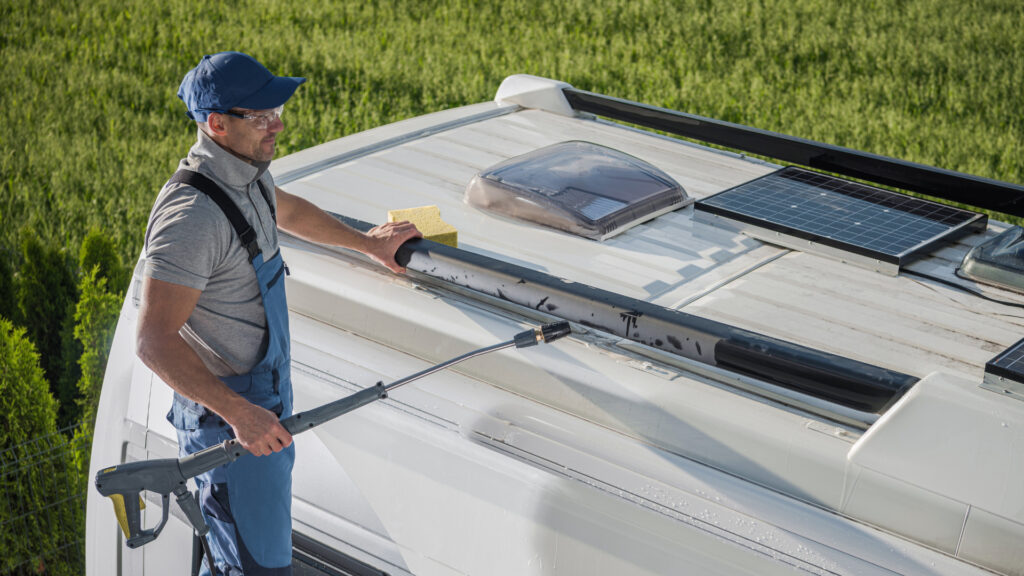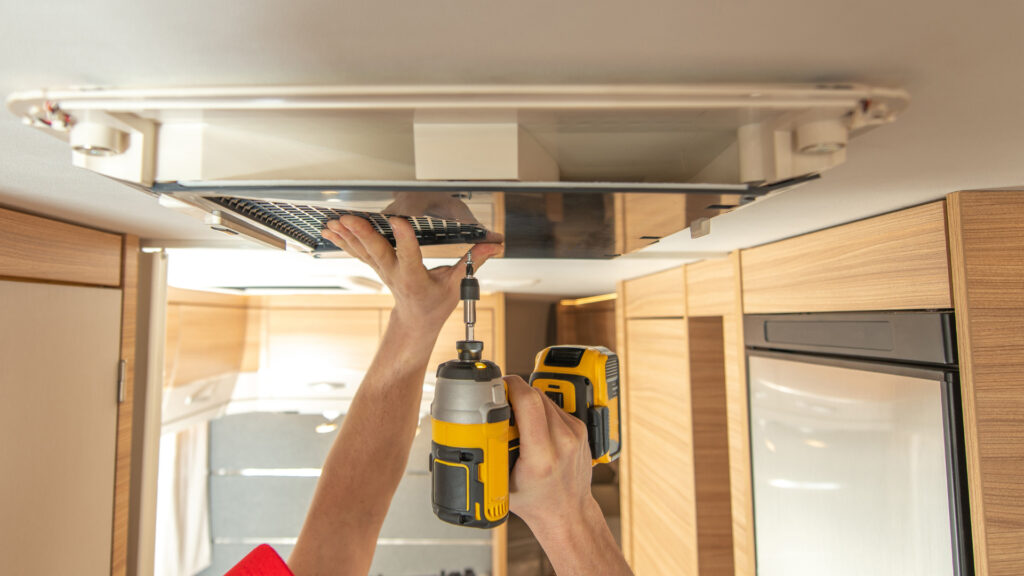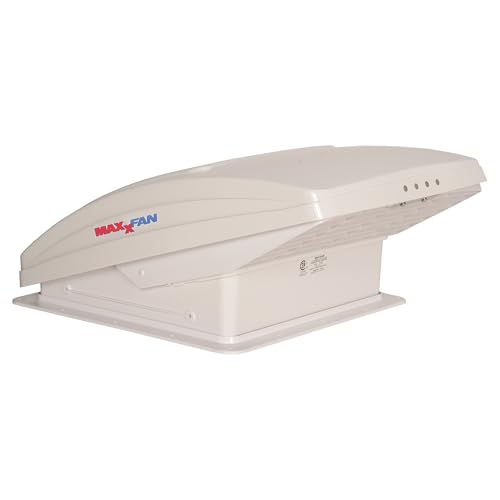Table of Contents Show
Cooling down your rig and removing odors from your RV are two primary reasons to invest in a high-quality RV vent fan. Maximizing air circulation in your camper is key to staying comfortable and eliminating smells from the kitchen or restroom. Most manufacturers use the cheapest options for fans they install in RV vents.
Today, we’re sharing a bit about the importance of RV vent fans and how you can easily upgrade. We’ll also provide you with options we think are worth considering. Let’s get started!
What Is An RV Vent Fan?
No matter how big or small your RV is, it’s likely to have at least one vent in the roof. These relatively small holes often have a retractable lid that you can open and close to increase or decrease air circulation. An RV vent fan increases the suction to pull air out of your RV.
Most standard RV vent fans will only pump air out. Despite having only one job, they often are mediocre at best and disappoint RV owners. The results owners experience from upgrading to a higher-quality RV vent fan are astronomical. Not only can higher-quality fans move more significant amounts of air, but they often blow air in both directions. Whether you want to rid your RV bathroom of steamy air from a hot shower or pull in the cool, fresh air at night, upgrading your RV vent fan is necessary.
Are RV Vents Standard Size?
The industry standard across the RV industry for vents is 14”x14”. Having a standard size is beneficial because you don’t have to stress about measuring errors. Because of this standard size, there is a wide range of RV vent fans, vent covers, and other products compatible with practically every RV.
Things To Consider When Shopping For An RV Vent Fan
It would be best to consider a handful of factors before purchasing an RV vent fan. Let’s take a look at what they are, so you can make an informed purchase and avoid buyer’s remorse.
Power Draw
If you spend most of your time camping in campgrounds or plugged into shore power, you won’t have to worry about power draw nearly as much. However, conserving and managing power is essential for campers who enjoy off-grid camping.
The best RV vent fans only use five amps on high and as little as one amp on low. You won’t have to worry about rapidly depleting your RV’s battery when using your fan. You can stay cool, eliminate odors, and use minimal power.
Noise Level
One of the worst things about cheap RV vent fans is their noise level. If you have a vent fan in your RV that is rather noisy, you may not want to use it. A loud fan can make it nearly impossible to have a conversation inside your RV. It can also make it challenging for light sleepers to doze off.
Sound is often subjective, and what’s loud to one person may not be audible to another. Decibels are how we measure the loudness or softness of a sound. Even higher-quality fans will be noisy on high; it’s the necessary evil of moving a lot of air. However, comparing the decibel ratings for fans on the levels you’ll use most is essential, especially if the noise level is a significant concern.

Reversible Air Flow
Most RV vent fans can only pull air out of an RV. They may have multiple speed settings but typically only spin in a single direction. This can be helpful if you want to get smells out while cooking, using the restroom, or pushing hot, humid air out of the bathroom after showering. However, having a fan with reversible airflow can be helpful, too.
If you want to stay cool in your RV, you need to keep the air moving. Opening windows and using a fan to pump in the fresh air can increase circulation.

Rain Cover
When you have a 14” x 14” hole in your RV’s roof, you’ll want to cover it when it’s raining. Most vents have a cover that can open and close when needed. Most RV vent fans aren’t waterproof or even water-resistant. If you leave your vent open and it starts to rain, you risk ruining your vent fan and causing water damage inside your rig.
Several manufacturers design vent covers. These covers connect to the vent and serve as a secondary cover. Once you install them, you can leave your covered vents open during a rainstorm or driving down the highway. You won’t have to worry about rain getting into your rig.
Keep in Mind: Do you need to cover your RV air conditioner? Let’s check out these 6 best RV AC covers
Manual or Remote Control
RV vent fans are either manual or remote-controlled. If you have a travel trailer or a pop-up camper, you may get by with a manual fan. You’ll have to flip a switch on the fan itself to turn it on. Some fans connect to an RV’s electrical system and have a button, similar to a residential bathroom.
If you’re not very tall or traveling in a high fifth wheel, there’s a chance you can’t reach all your fans. If this is you, it may be best to consider a fan with a remote. This can allow you to change the speeds or fan direction with a button or two.
The Best RV Vent Fans
Upgrading your RV vent fans is an easy upgrade that we think is worth it. This simple project has a significant return on investment, especially for those who enjoy clean air, staying chilled, and conserving power. Let’s look at the best options!
Our Choice: MaxxAir 7500 MaxxFan Deluxe
The MaxxAir 7500 is one of our favorite RV vent fans. It easily slides into a standard RV roof opening and comes with ten intake and exhaust speeds. It can move an impressive amount of air (900 CFM) and has an electric opening lid and remote control.
The fan’s motor uses the RV’s 12-volt electrical system to spin ten blades at 12” long. The sealed ball bearings ensure the fan blades spin smoothly and quietly when in use. Look no further if you’re in the market for the best RV vent fan.
- ALL-IN-ONE VENTILATION SOLUTION: The Maxxair Maxxfan Deluxe combines a vent, fan, and vent cover into a single unit,...
- POWERFUL 10-SPEED FAN: Experience optimal temperature control with the powerful 10-speed reversible fan equipped with a...
Runner Up: MaxxAir 5100 MaxxFan
The MaxxAir 5100 benefits from MaxxAir’s reputation for producing some of the highest quality fans in the RV industry. This fan comes with a built-in thermostat and rain shield. The one-of-a-kind system ensures that your RV’s interior is always safe from the rain and other weather.
This fan is slightly cheaper than the most expensive options from MaxxAir but is missing a feature or two. The most notable difference is that this fan does not have a remote. You’ll need to reach this model not only to turn it on and off but also to change speeds. This is an excellent choice if you can contact the fan easily or don’t want another remote lying around inside your RV!
- Built-In rain cover provides full time protection, while fan is on or off
- Use the fan while it's raining or when driving
Runner Up: Fan-Tastic 3350 RV Vent Fan
The Fan-Tastic 3350 is a fantastic option! This fan can circulate air at three speeds and reversible airflow. The built-in thermostat will turn the fan on and off to help keep your RV at the desired temperature. However, one of the best features is the rain sensor.
The Fan-Tastic 3350 comes with a rain sensor that will close the vent’s cover if it detects rain. This can be especially useful if you forget to close the vent when leaving your RV or have the vent open while sleeping. It can save you from a costly and inconvenient repair.
- Fits standard 14" x 14" openings
- Three fan blade speeds; Reversible air flow
Runner Up: Fan-Tastic 1250 Series RV Vent Fan
The Fan-Tastic 1250 is another excellent RV vent fan. This vent may be a more budget-friendly option, but it still packs a punch. The Fan-Tastic 1250 has three speeds, including reversible airflow. You’ll barely notice this fan humming along as it keeps you cool.
As this is a budget-friendly model, you lose many upgraded automatic features. However, reaching up to press a button to adjust the speed or direction of the blades often requires little effort. You’ll also need to close the lid of your fan when you leave or if there is rain in the forecast. This unit doesn’t have an automatic close feature like the newer, more expensive models.
- Fits standard 14" x 14" openings
- Three fan blade speeds
Budget Option: RVLovent 12V RV Roof Fan
RVLovent’s 12-volt exhaust fan is the perfect option for RVers looking to upgrade their fan on a budget. This powerful and efficient fan helps circulate air while using minimal power from the RV’s 12-volt system.
The fan has three speeds (low, medium, and high) and includes a reverse mode. This basic roof fan is more powerful than the standard vent fans most manufacturers put in their rigs. You don’t have to spend too much to keep air circulating, temperatures down, and odors out of your RV.
- 10-SPEED FAN Reversible and Manual lift.
- Powerful and Efficient: This RV roof fan provides a fantastic air circulation for your RV Tralier or Camper. And it...
How Do I Install An RV Fan?
Installing a new RV fan isn’t that difficult, but it will require you to climb on top of your RV, disconnect power, and turn off your RV’s battery. If you’re uncomfortable or unable to get onto your RV or work with electrical, you’ll want to hire a professional for this job.
Remove the screws holding the vent casing in place. You’ll need to climb onto your RV and remove the lid and roof sealant around the vent. Pry the vent away from the roof slowly and avoid aggressive movements that could damage your roof. Remove the old vent casing and prepare the roof for the new vent. Use a scraper to remove as much old sealant as you can.
When you have as much adhesive off as possible, use a rag and mineral spirits to clean the remaining gunk from the roof’s surface. This will be the most time-consuming part of the job, so take your time and do it right.
Now it’s time to install your new fan. Start by laying Dicor Butyl tape around the edges where the vent will screw into your RV’s roof. This creates a water-tight seal and helps prevent water from infiltrating your RV. Put the vent in place and mark the location for the screw holes. Remove excess butyl tape and apply self-leveling Dicor sealant over the screws to protect against water leaks.
Next, connect your fan to the 12-volt power. You can splice it into the existing wiring from the old fan or a nearby fixture. Turn the power on and confirm that you have a working fan before installing the inside cover and tightening the screws. If you work carefully and have the correct tools, this project will take no more than a few hours.
Keep in Mind: Keep your AC filter clean by knowing how to clean your RV air conditioner filter the right way!

Stay Cool With An RV Vent Fan
Camping season often means camping during warmer weather. You don’t want to be miserable because you’re camping in a stuffy RV. Upgrade your RV vent fan, and you can stay cool and comfortable and keep the smells and humidity out of your rig year-round. We’re confident one of the fans we’ve recommended will get the job done.
Which fan would work best for your rig?











